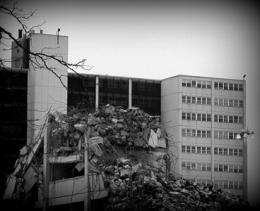Hope for Chicago: Moving city's poor out of troubled housing projects is having mixed results

In December 2010, the last remaining resident was removed from the last high-rise building standing in Chicago’s notorious Cabrini-Green housing projects, long a national symbol of urban blight. The relocation was part of Chicago’s ambitious Plan for Transformation, a 15-year enterprise aimed at breaking the poverty cycle in which tens of thousands of the city’s poor have lived, by moving them out of the projects and into better, safer living environments.
So far, according to a study by MIT researchers, the Plan for Transformation is faring only moderately well. Leaving the projects has produced positive psychological effects for some of Chicago’s poor, but has not appreciably improved their economic prospects, while relatively few participants in the program are living in drastically different types of housing.
“The results are mixed and nuanced,” says Lawrence Vale, Ford Professor of Urban Design and Planning at MIT, who produced the report along with Erin Graves, a former postdoctoral research associate in MIT’s Department of Urban Studies and Planning. The report, “The Chicago Housing Authority’s Plan for Transformation: What Does the Research Show So Far?” released in October by the MacArthur Foundation, surveys 83 previous studies of the Chicago plan conducted by social scientists.
On the positive side, the report notes that people leaving Chicago public-housing projects display better mental health; one study showed that the percentage of residents suffering anxiety problems in a given year dropped from 30 percent to 21 percent. Relocated residents also said they felt safer.
However, it is not clear that relocation helps residents increase their employment prospects and incomes. One study shows that among working-age public-housing residents, the proportion employed between 1999, when the plan was founded, and 2010, remained between 50 percent and 55 percent, including part-time workers. “The question of whether they’ve made significant economic gains is unresolved,” notes Vale.
Moreover, as Vale and Graves emphasize, only about 2,100 of the 26,000 households relocated as part of the Plan for Transformation have moved from the projects into mixed-income housing: the smaller, safer developments, where middle-income families are mixed in with low-income households.
“The public perception is that Chicago is replacing all of its infamous public housing with low-rise mixed-income communities,” says Vale. But as the report notes, about 9,000 households have moved to senior-only public housing, and 6,000 households have stayed in renovated public buildings that house only low-income residents. Similarly, Vale says, “The academic literature has focused on the least common experience, not on what the city has done with the majority of the housing.”
Is the Plan improving over time?
One major point of contention about the Plan for Transformation concerns the relocation services offered by the city. Households offered significant counseling about finding a new place to live fare better than those without counseling. But as media coverage often highlighted, those services were not widely available during the program’s first stages.
“I think things are better than they were in the early years,” says Vale. “But the mistakes made between 2000 and 2003 have had profound consequences for a large number of people involved in the program.”
In the report’s preface, the MacArthur Foundation notes that Chicago officials have long recognized that the Plan for Transformation “would always be a work in progress,” and adds that a survey of “the early designs, plans, programs, and policies … does not necessarily reflect the Plan’s implementation today.”
Experts on Chicago’s public housing think the MIT report properly emphasizes the complexities of the public-housing problem and its offered solutions. “Lawrence Vale’s work is very important,” says Bradford Hunt, an associate dean and professor of social science at Roosevelt University in Chicago, and author of the 2009 book, Blueprint for Disaster: The Unraveling of Chicago Public Housing (University of Chicago Press).
On the one hand, says Hunt, Chicago’s public housing problems required “massive quantities of change.” Indeed, the effort to dismantle notorious projects became a centerpiece of departing Mayor Richard Daley’s tenure. Then again, says Hunt, “The Chicago Housing Authority has invested so much energy in the plan, that I worry there is not enough energy or vision for the future beyond this.” The plan is slated to be terminated in 2015, and it is not clear what form public-housing services will take beyond that point.
Hope in the Hope VI era
One reason Chicago’s housing matters, Vale suggests, is that it is a lens for examining which government policies, if any, can change the fortunes of the country’s poor. “This is a fundamental challenge for our society,” says Vale. “How does a wealthy nation treat its poorest citizens? Public housing is a window into the distribution of inequality in America.”
Until the mid-20th century, Vale notes, in Chicago and across the nation, public housing was often “a kind of reward” for steadily employed working-class families who soon left for private housing. But by the 1960s and 1970s, the urban poor had become concentrated in high-rise projects. Then, in the 1980s, the transformation of Boston’s Columbia Point Housing Project initiated a trend toward smaller, mixed-income housing often built by private developers. The federal government’s Hope VI program subsequently awarded $6 billion in grants to redevelop public housing in this mode.
Currently, Vale is researching two books on the new approaches to public housing tried during the Hope VI era in seven American cities. Some, like Boston and San Francisco, have effectively mixed low-income and middle-income families in public housing; alternately, Atlanta has dismantled nearly all of its projects and given residents vouchers for the private market.
“As much as everybody concurs that concentration of the most vulnerable low-income households in large high-rise public housing projects was a bad idea, we don’t have a consensus on what to do next,” Vale says.
This story is republished courtesy of MIT News (), a popular site that covers news about MIT research, innovation and teaching.
Provided by Massachusetts Institute of Technology

















